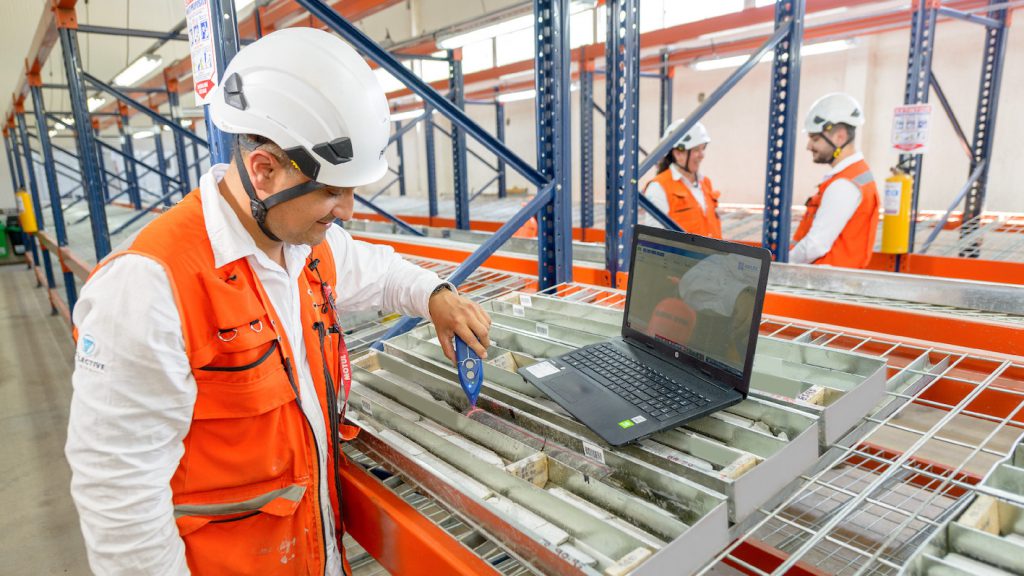Collective Mining drills 1.52 g/t AuEq over 358 metres at Guayabales, Colombia

Collective Mining Ltd. [CNL-TSXV; CNLMF-OTCQX] reported assay results from a further two drill holes completed within the Apollo porphyry system as well as visuals from a new exploratory drill hole at the 100%-optioned Guayabales project located in Caldas, Colombia.
Apollo is a high-grade, bulk tonnage copper-silver-gold system, which owes its excellent metal endowment to an older copper-silver and gold porphyry system being overprinted by younger precious metal rich, carbonate base metal vein systems (intermediate sulphidation porphyry veins) within a magmatic, hydrothermal inter-mineral breccia body currently measuring 395 metres x 385 metres x 915 metres and open for expansion.
Highlights: Hole APC-46 was drilled westward from Pad 6 and intersected a long and continuous interval of gold-silver-copper mineralization beginning at surface in oxide mineralization and bottoming in mineralization with results as follows: 358.0 metres grading 1.52 g/t AuEq (gold equivalent) from 5.75 metres downhole (consisting of 0.55 g/t gold, 31 g/t silver and 0.32% copper) including 19.25 metres of 3.01 g/t AuEq in oxides; and
60.55 metres of 2.69 g/t AuEq from 153.05 metres downhole.
APC-46 extended the strike length of the shallow mineralization to the west with the dimensions now measuring 160 metres x 130 metres (previously 150 metres x 130 metres).
APC-46 bottomed in mineralization in quartz diorite porphyry with the final 7.1 metres averaging 0.88 g/t AuEq.
APC-44 was drilled to the northwest from Pad 6 and intercepted a long and continuous zone of gold-silver-copper mineralization beginning at surface in oxide material and bottoming in mineralization with results as follows: 428.2 metres of 1.41 g/t AuEq from 2 metres downhole (consisting of 0.61 g/t gold, 29 g/t silver and 0.24% copper) including 19.95 metres of 3.07 g/t AuEq in oxides; and 18.25 metres of 5.21 g/t AuEq from 144.25 metres downhole.
Detailed visual logging of drill hole APC-53, which was drilled to the northeast from Pad 10, indicates that two potentially significant zones of mineralization were encountered along the hole. APC-53 was designed to step-out along the recently announced “Contact Zone” where drill hole APC-42 cut 104.8 metres from surface at 5.56 g/t AuEq.
The first zone was intersected over approximately 150 metres from surface and consisted of intense sheeted “CBM” veins hosted within mineralized quartz diorite porphyry. This is the first time that the Company has observed such an intense set of sheeted CBM veins hosted outside of breccia and represents a potentially high-grade target for follow up drilling.
The second continuous zone of mineralization in APC-53 was logged beginning at approximately 233 metres downhole and running for up to 280 metres in length. An abundance of sulphide mineralization within a breccia matrix was observed and is comparable in intensity to the sulphide levels logged in APC-42.
Assay results for this hole are expected in June 2023.
Eight additional holes have been completed at the Apollo system with assay results for APC-45, APC-47 and APC-48 expected in the near term.
Ari Sussman, Executive Chairman commented: “The first part of our 2023 drilling program, which was focused on outlining the near surface portion of the Apollo system is nearing completion. The next phase of the program is already underway and will focus on growth by looking to expand the Apollo system with step-out drilling and by testing satellite targets surrounding Apollo and other targets on the greater Guayabales property. The visual observations from APC-53 are very exciting as the Contact Zone hosts an intensity of sheeted CBM veins not observed yet elsewhere at the project. We look forward to continuing drilling this new area as we look to unlock its high-grade potential.”
The Phase II drilling program of 2023 is advancing on schedule with 15 holes completed and results announced. A further eight holes have been drilled and await assay results. The objectives of the 2023 program are to define the high-grade mineralization and dimensions of the Apollo porphyry system near surface, expand the size of the system through step-out and directional drilling and drill test multiple new targets generated through grassroots exploration. Since the announcement of the discovery hole at Apollo in June 2022, a total of 46 drill holes (approximately 20,700 metres) have been completed and assayed.
The company presently has three diamond drill rigs operating at the Apollo project. A fourth drill rig is being mobilized to the project and is expected to initiate testing of the new exploration targets identified around Apollo in June 2023.
